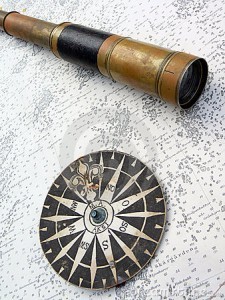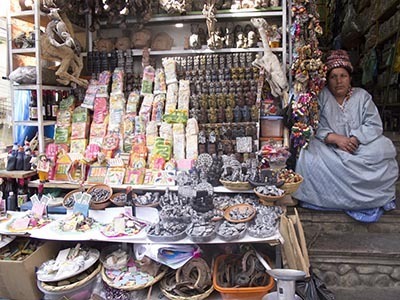Rolf Potts's Blog, page 79
October 8, 2012
“Travel is fatal to prejudice”: a web comic
Vagablogging :: Rolf Potts Vagabonding Blog

Three bears steering peace signs. Photo: Keith / Flickr
There’s a great quote by the writer Mark Twain that goes:
Travel is fatal to prejudice, bigotry, and narrow-mindedness, and many of our people need it sorely on these accounts. Broad, wholesome, charitable views of men and things cannot be acquired by vegetating in one little corner of the earth all one’s lifetime.
Gavin Aung Than, a freelance illustrator in Melbourne, Australia memorably brought those words to life in this web comic on Zen Pencils: Mark Twain, an educational journey. The Zen Pencils website is full of gems like this. Than takes inspirational quotes and transforms them into graphic parables about the important lessons in life.
Do you have a favorite quote about travel? Please share them in the comments.
Original article can be found here: “Travel is fatal to prejudice”: a web comic
October 7, 2012
Nothing is more American than fleeing what is American overseas
Vagablogging :: Rolf Potts Vagabonding Blog
“On the highway to Toledo [Spain] we passed several tour buses full of what looked like Americans, digital cameras already in hand, and as we drew past them I expressed infinite disdain, which I could easily do with my eyebrows, for every tourist whose gaze I met. My look accused them of supporting the war, of treating people and the relations between people like things, of being the lemmings of a murderous and spectacular empire, accused them as if I were a writer in flight from a repressive regime, rather than one of its most fraudulent grantees. Indeed, whenever I encountered an American I showered him or her with silent contempt and not just the loud, interchangeable frat boys calling each other by their last names, calling each other fags, and the peroxided, inevitably miniskirted sorority girls spending their junior year abroad, dividing their time between internet cafes and discotecas, complaining about the food or water pressure in the households of their host families, having chosen Spain over Mexico, where Cyrus was, because it was safer, cleaner, whiter, if farther from their parents’ gated communities. I had contempt not just for the middle-aged with their fanny packs and fishing hats and whining kids, or the barbate backpackers who acted as though failing to shower were falling off the grid; rather, I reserved my most intense antipathy for those Americans who attempted to blend in, who made Spanish friends and eschewed the company of their countrymen, who refused to speak English and who, when they spoke Spanish, exaggerated the peninsular lisp. At first I was unaware of the presence in Madrid of these subtler, quieter Americans, but as I become one, I began to perceive their numbers; I would be congratulating myself on lunching with Isabel at a tourist-free restaurant, congratulating myself on making contact with authentic Spain, which I only defined negatively as an American-free space, when I would catch the eyes of a man or woman at another table, early twenties to early thirties, surrounded by Spaniards, reticent compared to the rest of the company, smoking a little sullenly, and I knew, we would both know immediately, that we were of a piece. I came to understand that if you looked around carefully as you walked through the supposedly less touristy barrios, you could identify young Americans whose lives were structured by attempting to appear otherwise, probably living on savings or giving private English lessons to rich kids, temporary expatriates sporting haircuts and clothing that, in hard-to-specify ways, seemed native to Madrid, in part because they were imperfect or belated versions of American styles. Each member of this shadowy network resented the others, who were irritating reminders that nothing was more American, whatever that means, than fleeing the American, whatever that is, and that their soft version of self-imposed exile was just another of later empire’s packaged tours.”
–Ben Lerner, Leaving the Atocha Station (2011)
(2011)
Original article can be found here: Nothing is more American than fleeing what is American overseas
October 6, 2012
Vagabonding Field Report: León and her volcanoes, Nicaragua
Vagablogging :: Rolf Potts Vagabonding Blog
Cost: $20 a day
What’s the strangest thing you’ve seen recently?
Volcano boarding down the slopes of Cerro Negro, outside of León, Nicaragua has become a popular activity with travelers, especially since making number two on CNN Go’s Thrill Seeker’s Bucket List. Ignorant as to what was involved in this new sport I had visions of cutting sharp turns in powdery volcanic ash, much as as snowboarder would in fresh powder. In actuality volcano boarding is far from graceful. Instead of standing on the board you sit down as one would on a sled. There’s a loop of rope you hold onto like reigns, which gives you some semblance of control as you hurtle over jagged bits of volcanic rubble. Orange jumpsuits and protective goggles are worn to prevent bits of volcano from piercing skin and eyeball. Participants look a bit like extras for Walter White during a meth cook. After a short ¨How to Volcano Board¨ introduction the group I was with started down the slope one by one. It quickly became apparent that the protective attire was rather important. Over half of our group fell off their boards showering themselves in bits of basalt as they spun and rolled like a gran prix cars crashing off circuit. I managed to keep my butt plastered to the plank of wood but only reached a measly 57km an hour. A feather weight girl in our crew reached 83km an hour before her head met the slope in an unwanted embrace. Fortunately she was fine and won bragging rights for the day.
[image error]
The only thing more badass than Volcano boarding is doing said activity with a glorious beard
Describe a typical day
Volcano based activities are plentiful around León and plenty of time is spent scrambling up steep slopes for the rewards upon reaching one of the summits. From atop Volcán Telica you can stare into its immense crater and watch magma slosh around as it farts noxious sulfurous gases. Volcán Momotombo offers expansive views of lesser volcanos, glassy Lake Nicaragua and the Pacific Ocean. And Cerro Negro, of course offers a bumpy ride at high velocity astride a volcano board.
In León itself I occupy myself by organizing the next adventure at non profit Quetzal Trekkers, eating cheap street food (hamburgers or a variation of chicken, beans and rice), or playing pool and foozeball over a couple of Toña beers, which appropriately have an image of Volcán Momotombo adorning the label.
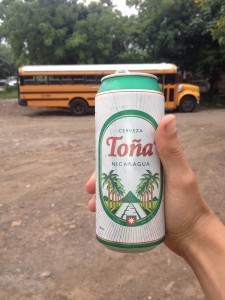
Toña
Describe an interesting conversation you’ve had with a local
Frustratingly my Spanish is still not good enough to have a thoroughly interesting chat with a local. I’ve had the same conversation many times: where are you from? How old are you? Do you study or work? So you’re an animal doctor? Does that mean you have to kill lots of animals? I crave the ability to communicate on a deeper level and would love to be able to make a joke in Spanish that results in laughter, rather than total confusion.
What do you like about where you are? Dislike?
Despite being amongst the poorest people within Central America, Nicaraguans happen to be amongst the friendliest and, for the most part, Leon is a safe city that you can walk around freely day or night. This came as a great relief after spending time in La Ceiba and Tegucigalpa, where I felt as if a shanking was in order if I happened to wander around after dark. Nicaragua is inexpensive to travel through and the locals don’t apply gringo tax as liberally as in other parts of Central America. On top of all this the volcanic landscape and close proximity to the pacific ocean make Leon a great base for outdoor enthusiasts.
The volcanic landscape is undoubtedly one of Nicaragua’s greatest assets, yet many of the locals fail to grasp this and don’t think twice about hurling trash out of bus windows. I cringe when I see lush swathes of vegetation riddled with the refuse of careless people. An additional annoyance regarding Leon itself is that, like many other Latin American cities, it’s plagued by a constant bleating of car horns. Do you know what sounding off with your car horn every five seconds achieves? Nothing. Nothing at all.
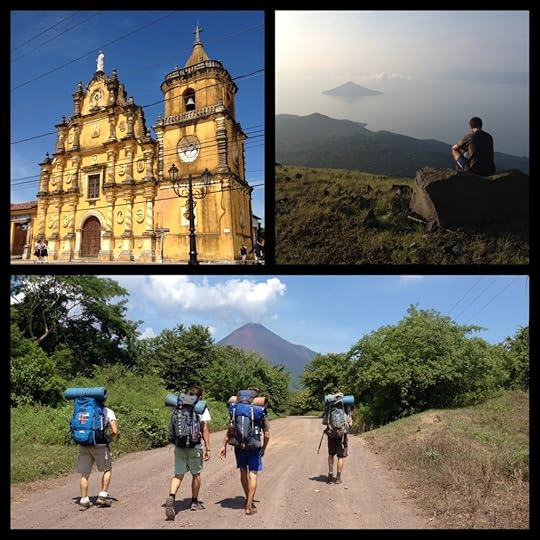
León and its surrounds
Describe a challenge you faced.
I’e given myself five and a half months to travel through Latin America, a time period that really doesn’t do the area justice. To expedite the process of getting to South America I decided to fly, rather than race down to Panama and sail to Colombia. You would think that flying to South America would be inexpensive given the short distances involved, however I’ve found this isn’t case. I spent hours giving myself a headache in trying to figure out the cheapest way to get to South America. Eventually I had to settle on a flight through Florida to Lima (not a very environmentally friendly option despite my frustration over the locals littering).
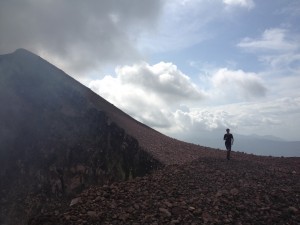
Volcán Telica
What new lesson did you learn?
After three months of wandering around somewhat aimlessly in Central America I’ve come to the conclusion that having a rough plan can be helpful indeed. It can reduce the hassle involved and time spent skimming through guide books and blogs last minute tryig to find a source of direction. The prices of flights from Central to South America wouldn’t have come as such a shock to me with a little foresight. Plans can always be discarded if you’re craving some spontaneity. Rolf talks a about this a bit in Chapter 4 of Vagabonding.
Where to next?
Peruvian Andes
You can follow me on Twitter @ash_jordan and Instagram @ashgjordan
Original article can be found here: Vagabonding Field Report: León and her volcanoes, Nicaragua
October 5, 2012
Special October 2012 fares for multi-stop tickets on BootsnAll
Vagablogging :: Rolf Potts Vagabonding Blog
This past week on BootsnAll, we focused on the idea of career breaks, a movement that has been gaining steam in the United States over the last decade, but one that is still quite foreign to most of the population.
Our friends over at Meet, Plan, Go are gearing up for their third annual nation-wide event on October 16, 2012, in 10 cities across North America, where they promote the idea of career break travel and help others realize that this isn’t such a far-fetched idea.
The Inside Scoop on Career Breaks has many of the Meet, Plan, Go! hosts discussing what it was about their career break that has changed their lives. In Why a Gap Year Should Come to America, author Katie Aune, who just returned from a year + long career break adventure through all the former countries of the Soviet Union, talks about why it would be beneficial for the United States to adopt the idea of taking a career break.
If you are interested in the idea of taking a break from your job to travel the world, then check out the city closest to you and get your tickets for the third annual Meet, Plan, Go! event:
Austin
Boston
Chicago
Minneapolis
New York
San Diego
San Francisco
Seattle
South Florida
Toronto
If you are ready to take a career break and hit the road, then check out these five fares that we’ve found on Indie, BootsnAll’s Multi-Stop Trip Planner:
Iconic City RTW – $2085 - New York City > Paris > Singapore > New York City - $2085 taxes and fees included
Epic Wine Regions of the World RTW – $5785 – San Francisco > Auckland > Sydney >overland> Adelaide > Cape Town > Florence >overland> Bordeaux >overland> Lisbon > San Francisco from $5785 taxes and fees included
Ridiculous RTW – $9125 – Denver > Mexico City >overland> Panama City > Quito > Buenos Aires > Ushuaia > Auckland > Sydney > Bali > Manila > Hanoi >overland> Bangkok > Kathmandu > Delhi > Moscow > Berlin > London > Reykjavik > New York > Toronto > Denver from $9125 taxes and fees included
Circle Asia from London – $1635 – London > Moscow > Beijing > Delhi > London from $1635taxes and fees included
Around the World from Sydney – $3423 – Sydney > Honolulu > San Francisco > New York > Barcelona >overland> Rome > Mumbai >overland> Delhi > Bali > Sydney from $3423 taxes and fees included
Original article can be found here: Special October 2012 fares for multi-stop tickets on BootsnAll
October 4, 2012
The Royal Geographical Society: Still a treasure in its third century
Vagablogging :: Rolf Potts Vagabonding Blog
Located in a classy but nondescript building in the Kensington neighborhood of London, the Royal Geographical Society is not your normal tourist attraction—but it should hold a special place in every traveler’s heart. Founded in 1830 as a dinner club hosting lectures from hearty travelers, the Society (or RGS as it’s often called) became a world-class institution for the advancement of knowledge about the planet.
With generous endowments, the RGS evolved into a training hub and planning headquarters for several famous Victorian and Edwardian explorers such as Livingstone, Darwin, Shackleton and Burton. They and other like-minded adventurers—all partially financed, trained by and associated with the RGS—mapped rivers in Africa, measured mountains in Asia, reached the North and South poles, discovered islands in the South Pacific, and carried out zoological studies everywhere. The official creed of the RGS was that no corner of the planet was too remote, too obscure, or too dangerous.
The rich heritage of the RGS earned it a role in my new novel, “Dangerous Latitudes”, about an adventurous travel writer on an extraordinary expedition. As the lead character Matthew Hunt explains to a colleague, “The RGS was the NASA of its time, training explorers and then sending them off on expeditions to learn about the world and return with new insights. Think Dr. Livingston and Darwin. Guys like that were the astronauts to the RGS’ NASA. And the places they went seemed just as remote to them as other worlds seem to us.”
The explorers who survived their journeys brought back amazing tales of new lands, new cultures, and new ways of looking at the world. The well-maintained RGS archives are an array of sextants, telescopes, compasses, charts and diaries comprising a breathtaking chronicle of human exploration—and almost all of them were from expeditions done when the telegraph was new, and airplanes and antibiotics were still just a dream.
Today the RGS promotes research and education as it transitions into the new millennium, and its archives are considered a treasure to historians and scientists alike. The next time you’re in London, get off at the South Kensington tube stop and drop by their headquarters (near Royal Albert Hall) to peruse the collections of hand-scrawled maps, drawings, and field notes made by the astronauts of another era. I dare you not to be inspired.
Original article can be found here: The Royal Geographical Society: Still a treasure in its third century
Food makes travel memories
Vagablogging :: Rolf Potts Vagabonding Blog
For this week I would like to stay away from my usual “reflective topics” and investigate something much simpler: food. I started thinking of travel and food as I stumbled upon this article on Asia’s 10 greatest street food cities. As I am currently in Bulgaria and have seen many countries and sampled much of their cuisines along my way from Asia, I reckon that food, and especially, street food, is unmistakably one of the reasons why I enjoy travelling.
Photo credit: Flickr/GlobalCitizen01
To me, food and street food in particular are essential travel elements: living in Penang – where I can get ultra-cheap, mouthwatering delicacies at every corner 24/7-, food options are able to shape my travel experiences. Do you need a simple example? I would pick the Central Asian region. As I think of every one of the ‘stans I visited, I cannot keep that mutton stew’s smell out of my mind… and my mouth. So, my most obvious Central Asian travel memories will always be drenched in that overcooked sheep’s fat smell; and instead, as I think of Iran, the delicate spiciness of their feta cheeses spread over oven roasted bread paints each and every one of my travel memories.
And as much as I do not really travel to experience food only as others may decide to do, It appears that I mostly remember a place by its smells, its street foods’ colors, shapes and tastes. Some countries may even feel nicer because I had the chance to experience better food. For sure, the food variety definitely makes a destination much more appealing. Honestly, there is nothing wrong against Central Asia or Nepal, but after weeks of the same langman noodles and momos diet, memories kind of jade around the edges and smell like that. They became associated with a taste: the Himalaya tastes like hot, saucy meat buns you will find anywhere and everywhere in different forms and shape… but definitely a similar content. So my dear Himalaya, your peaks smells like those same hot momos in vinegar sauce I had in every village I visited!
Try to close your eyes and remember some of your life’s best trips: now, think better. Can you agree that you probably remember those places because of the quality of the food you indulged in?
If I close my eyes and think of the first memory of a place I may associate with a country, I personally see a much brighter Thailand compared to Uzbekistan. Somehow, the food’s taste is always there, biting at the back of my mind.
Do you agree? Is there any particular place or country that you highly remember because of the taste of foods associated with your own experience? Please comment, I think it is quite interesting.
Original article can be found here: Food makes travel memories
October 3, 2012
How to avoid crying babies on flights
Vagablogging :: Rolf Potts Vagabonding Blog

Crying baby. Photo: a4gpa / Flickr
You’re excited. You’ve just boarded a plane to start your vagabonding journey. Then it happens: a baby starts crying. Sometimes it gets worse: other babies start crying too. What was going to be a relaxing flight has turned into a scream-fest. If you don’t have noise-cancelling headphone on hand, what can you do?
Air Asia X has approached this problem by creating a Quiet Zone on its long-haul planes. Starting February 2012, the first seven rows in economy class will be reserved for guests age 12 and above. The nice thing is that there is no extra charge for this preferential seating.
Would you prefer airlines to go further, say having an entire class that’s for adults only or flights that are child-free? Worth an extra fee? If you have horror stories, how did you deal with this? Let us know your thoughts in the comments.
Original article can be found here: How to avoid crying babies on flights
October 1, 2012
The joys of roadschooling
Vagablogging :: Rolf Potts Vagabonding Blog
 Kids are naturally curious and have an innate desire to make sense of the world around them. In other words – they want to learn. Have you ever seen your child out digging in the ground, trying to pull earthworms out of the dirt? And then that same child proudly shows you all the segments and explains how the worm wiggles to move? She is simply trying to put the pieces together to make sense of what’s around her.
Kids are naturally curious and have an innate desire to make sense of the world around them. In other words – they want to learn. Have you ever seen your child out digging in the ground, trying to pull earthworms out of the dirt? And then that same child proudly shows you all the segments and explains how the worm wiggles to move? She is simply trying to put the pieces together to make sense of what’s around her.
Kids have an inborn inclination to want to make sense of their world. Unfortunately, our school system tends to beat that curiosity out of kids – too often, schools take “learning” and make it boring, repetitive, and irrelevant. And that is a pity indeed.
Many families have opted out of a ‘traditional’ education, and have chosen instead to take their children out to see the world – whether in RVs, planes, buses, or bicycles. Roadschooling families make a conscious effort to capitalize on children’s natural penchant toward learning. They go out of their way to visit historical and/or scientific sites in order to arouse that sense of curiosity in children. And roadschooled kids learn the joy of learning.
As families travel throughout the world visiting historical sites, children gain an understanding of what life was like on the fields of Gettysburg or in ancient Mayan cities. They visit museums and national parks and natural wonders. Roadschooling parents encourage their children to learn from everything surrounding them and the kids learn in a natural learning environment.
What could be better than learning by doing? By being there in person, by seeing and hearing and touching and living? For many of us – there is nothing better!
Nancy Sathre-Vogel, a long-time classroom teacher, made the decision to quit her teaching job and join the ever-burgeoning ranks of homeschoolers. Together with her husband and children, she cycled the length of the Americas seeking out educational opportunities of every stripe and color. She blogs at www.familyonbikes.org
Original article can be found here: The joys of roadschooling
September 30, 2012
The rest of the world has been transformed by the possibility of access
Vagablogging :: Rolf Potts Vagabonding Blog
“The great geographical Other, the faraway rest of the world, has been transformed by the pure possibility of access. The numbers of distance and time no longer mean what they used to. Every place, once unique, itself, is strangely shot through with radiations from every other place. “There” was then; “here” is now.”
–Sven Birkerts, The Gutenberg Elegies: The Fate of Reading in an Electronic Age (1994)
(1994)
Original article can be found here: The rest of the world has been transformed by the possibility of access
September 29, 2012
Vagabonding Field Report: living the high life in La Paz
Vagablogging :: Rolf Potts Vagabonding Blog
What ’ s the strangest thing you ’ ve seen lately?
Hundreds of llama foetuses at the witches market in the centre of La Paz. People buy them and bury them under their porches to bring luck and prosperity to their families. It wasn’t the most pleasing sight for a vegetarian, although I’m told most have died naturally.
Describe an interesting conversation you had with a local:
We couchsurfed for a couple of days in one of the more wealthy areas of La Paz and went to a house party with our host. It was fascinating to see a side of La Paz away from the touristic centre. We met a man who is creating La Paz’s first raw food restaurant, another who, after being expelled five times, now runs his own alternative after-school learning club. We also talked with the captain of the ultimate frisbee team who is trying to popularise the sport in Bolivia. After training in the dizzying heights of La Paz, his team will be at an advantage on lower ground.
What do you like about where you are? Dislike?
La Paz is the most dramatically situated city I have ever seen, built into the side of a mountainous valley, and surrounded by snow-capped mountains. Sheer mountain face punctuates the precariously positioned houses and, if you venture further afield, you can explore the otherworldly landscape of the Luna Valley. This was enough to make me love the city but if I could change one thing, it would be the altitude. I found it deeply uncomfortable never being able to get on top of my breath, and it made exploring the city very tiring.
Describe a challenge you faced:
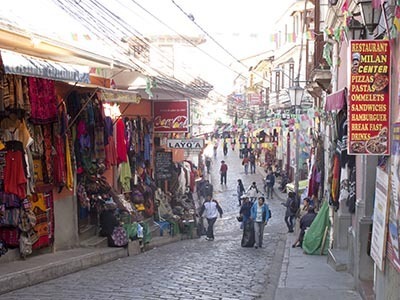 The altitude was the biggest challenge we faced. At one point I had to see a doctor and I was starting to get a pain in my chest, which the powers of Google told me was a bad sign. It turned out it was nothing to worry about, but it was scary at the time. I think it’s good to take these things seriously, just in case they are, but also be wary of scaring yourself with self-diagnosis.
The altitude was the biggest challenge we faced. At one point I had to see a doctor and I was starting to get a pain in my chest, which the powers of Google told me was a bad sign. It turned out it was nothing to worry about, but it was scary at the time. I think it’s good to take these things seriously, just in case they are, but also be wary of scaring yourself with self-diagnosis.
What new lesson did you learn?
I learned that the traditional bowler hats you see Bolivian women wearing originate in the UK where they were worn by railway workers. However, I’m not sure how the craze caught on, and stuck, for Bolivia’s women. The hats are often worn as a sign of social status, some costing much more than a monthly salary.
Where next?
Next up is Ecuador, followed by a month-long teacher training course in Mexico.
Read more about our travels on our blog Bridges and Balloons.
Original article can be found here: Vagabonding Field Report: living the high life in La Paz
Rolf Potts's Blog
- Rolf Potts's profile
- 323 followers




